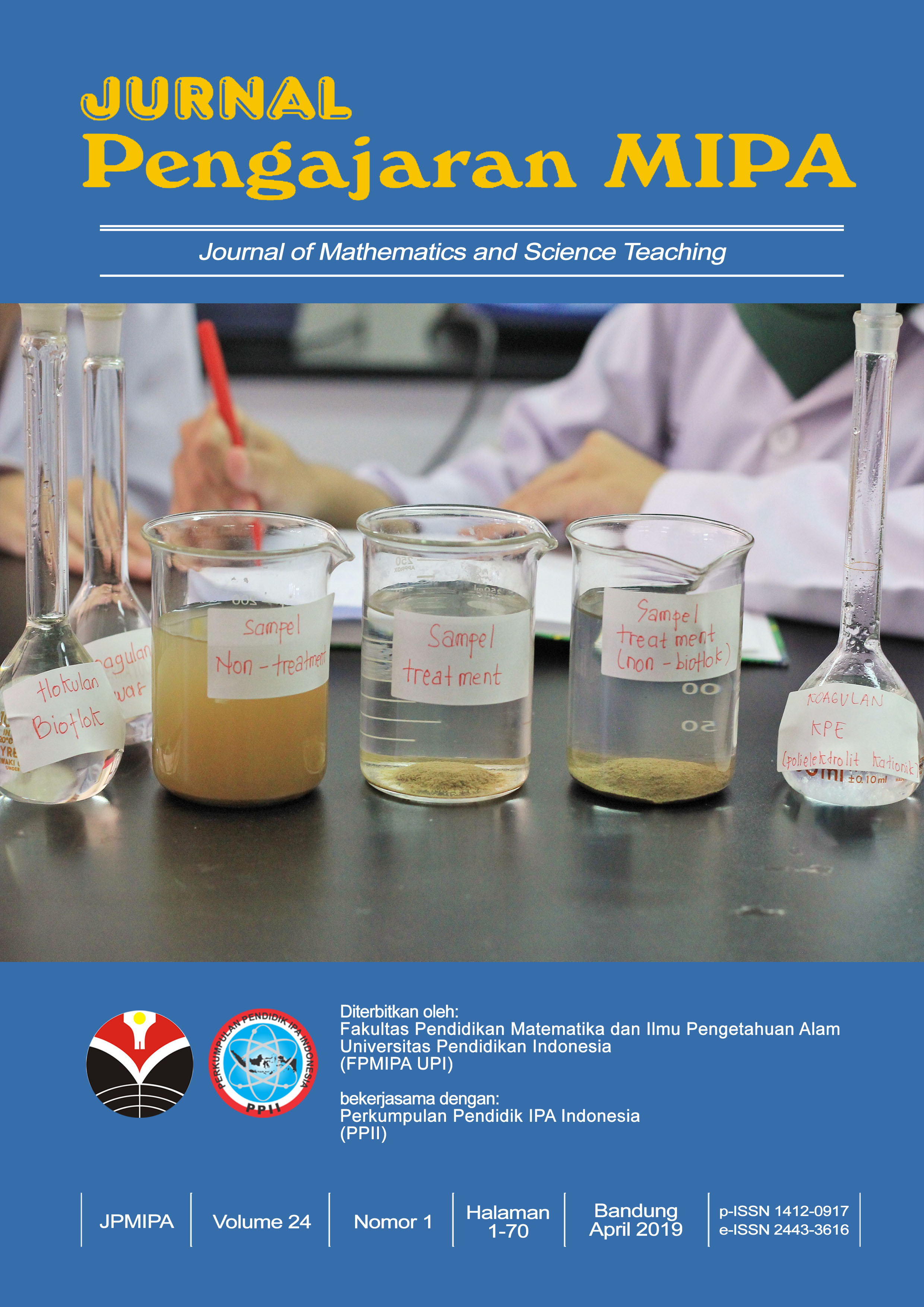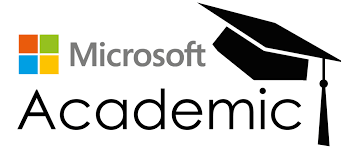ASSESSING STUDENTS’ MISCONCEPTIONS ABOUT PURE SUBSTANCES, MIXTURES, AND SEPARATION OF MIXTURES USING A FOUR-TIER DIAGNOSTIC TEST
Abstract
References
Amelia, M., Thomas, M. M., & Rusyati, L. (2023). Analysis of students misconceptions about reproduction in plants using a four-tier diagnostic test. Jurnal Pendidikan Matematika dan IPA, 15(2), 287-301. https://doi.org/10.26418/jpmipa.v15i2.68888
Ambarita, T. I., & Rusyati, L. (2025). Four-Tier Diagnostic Test to Assess Student Misconceptions About the Human Circulatory System. Prisma Sains: Jurnal Pengkajian Ilmu dan Pembelajaran Matematika dan IPA IKIP Mataram, 13(1). https://doi.org/10.33394/j-ps.v13i1.11637
Arini, A. D., Azizah, U., Satriawan, M., & Saphira, H. V. (2025). Analyzing Students' Misconceptions Based on Submicroscopic Level Representation in Elements, Compounds, and Mixtures. Jurnal Penelitian Pendidikan IPA, 11(2), 25-34. https://doi.org/10.29303/jppipa.v11i2.10052
Bayuni, T. C., Sopandi, W., & Sujana, A. (2018). Identification misconception of primary school teacher education students in changes of matters using a five-tier diagnostic test. Journal of Physics: Conference Series, 1013(1). https://doi.org/10.1088/1742-6596/1013/1/012086
Cahyanto, M. A. S., Ashadi, A., & Saputro, S. (2019a). An analysis of gender difference on students’ misconceptions in learning the material classification and its changes. Jurnal Inovasi Pendidikan IPA, 5(2), 157-167..pdf. Jurnal Inovasi Pendidikan IPA, 5(2), 157–167. https://doi.org/doi:https://doi.org/10.21831/jipi.v5i2.26613
Cahyanto, M. A. S., Ashadi, & Saputro, S. (2019b). Analysis of Students’ Misconception Based on the Use of Learning Objectives in Classification of Materials and Their Properties. Journal of Physics: Conference Series, 1397(1). https://doi.org/10.1088/1742-6596/1397/1/012019
Caleon, I. S., & Subramaniam, R. (2010). Do students know What they know and what they don’t know? Using a four-tier diagnostic test to assess the nature of students’ alternative conceptions. Research in Science Education, 40(3), 313–337. https://doi.org/10.1007/s11165-009-9122-4
Creswell, J. W. (2012). Educational Research Planning, Conducting, and Evaluating Quantitative and Qualitative Research (M. Buchholtz (ed.); Fourth Edi). Pearson Education, Inc.
Damsi, M., & Suyanto, S. (2023). Systematic literature review: multiple-tier diagnostic instruments in measuring student chemistry misconceptions. Jurnal Penelitian Pendidikan IPA, 9(5), 8-21. https://doi.org/10.29303/jppipa.v9i5.2600
da Silva, R. A., & de Vasconcelos, F. C. G. C. (2022). Learning through chemistry simulations: an analysis of cognitive skill levels. Education and Information Technologies, 27(5), 6967-6987. https://doi.org/10.1007/s10639-022-10911-1
dos Santos, G. P., de Morais, D. R., de Souza, C. I. F. R., Fonseca, N. A. R., & Miranda, M. L. D. (2021). Mixtures and their separation methods: The use of didactic games, the jigsaw method and everyday life as facilitators to construct chemical knowledge in high school. Orbital: The Electronic Journal of Chemistry, 428-433. http://dx.doi.org/10.17807/orbital.v13i5.1650
Fraenkel, J., Wallen, N., & Hyun, H. (2011). How to Design and Evaluate Research in Education (8th ed.) [E-Book]. McGraw-Hill Education.
Fuadi, F. N., Sopandi, W., & Sujana, A. (2021). The mastery of grade 4 of elementary school students’ concepts on energy through the implementation of the RADEC learning model. Journal of Physics: Conference Series, 1806(1). https://doi.org/10.1088/1742-6596/1806/1/012140
Gkitzia, V., Salta, K., & Tzougraki, C. (2020). Students’ competence in translating between different types of chemical representations. Chemistry Education Research and Practice, 21(1), 307-330. DOI: 10.1039/c8rp00301g
Gurel, D. K., Eryilmaz, A., & McDermott, L. C. (2015). A review and comparison of diagnostic instruments to identify students’ misconceptions in science. Eurasia Journal of Mathematics, Science and Technology Education, 11(5), 989–1008. https://doi.org/10.12973/eurasia.2015.1369a
Hermita, N., Suhandi, A., Syaodih, E., Samsudin, A., Isjoni, Johan, H., … Safitri, D. (2017). Constructing and Implementing a Four Tier Test about Static Electricity to Diagnose Pre-service Elementary School Teacher’ Misconceptions. Journal of Physics: Conference Series, 895(1). https://doi.org/10.1088/1742-6596/895/1/012167
Imaduddin, M., Shofa, M.M., Riza, M.F. and Fikri, A.A., 2023. Exploring the pre-service basic science teachers’ misconceptions using the six-tier diagnostic test. Int J Eval & Res Educ ISSN, 2252(8822), p.1627. DOI: 10.11591/ijere.v12i3.24603
Kaniawati, I., Fratiwi, N. J., Danawan, A., Suyana, I., Samsudin, A., & Suhendi, E. (2019). Analyzing students’ misconceptions about Newton’s Laws through Four-Tier Newtonian Test (FTNT). Journal of Turkish Science Education, 16(1), 110–122. https://doi.org/10.12973/tused.10269a
Kartimi, K., Yunita, Y., Fuadi, F. N., & Addiin, I. (2021). A Four-tier Diagnostic Instrument: An Analysis of Elementary Student Misconceptions in Science Topic. Jurnal Penelitian Pendidikan IPA, 7(SpecialIssue), 61–68. https://doi.org/10.29303/jppipa.v7ispecialissue.1022
Kingir, S., Geban, O., & Gunel, M. (2013). Using the Science Writing Heuristic Approach to Enhance Student Understanding in Chemical Change and Mixture. Research in Science Education, 43(4), 1645–1663. https://doi.org/10.1007/s11165-012-9326-x
Kiray, S. A., & Simsek, S. (2021). Determination and Evaluation of the Science Teacher Candidates’ Misconceptions About Density by Using Four-Tier Diagnostic Test. International Journal of Science and Mathematics Education, 19(5), 935–955. https://doi.org/10.1007/s10763-020-10087-5
Laisaroh, A., Mustadi, A., & Rahayu, A. (2020). The analysis of elementary university-students ‘misconceptions in basic science concept utilizing the Certainty of Response Index (CRI). Jurnal Pengajaran Matematika dan Ilmu Pengetahuan Alam, 25(1), 27-33. https://doi.org/10.18269/jpmipa.v25i1.17520
Omilani, N. A., & Idika, M. I. (2020). An Investigation into the reasoning of pre-service integrated science teachers when classifying matter into elements and compounds. Creative Education, 11(12), 2512-2522. https://doi.org/10.4236/ce.2020.1112184
Pikoli, M. (2020). Using guided inquiry learning with multiple representations to reduce misconceptions of chemistry teacher candidates on acid-base concept. International Journal of Active Learning, 5(1), 1-10.
Rahmawati, Y., Hartanto, O., Falani, I., & Iriyadi, D. (2022). Students’ conceptual understanding in chemistry learning using PhET interactive simulations. Journal of Technology and Science Education, 12(2), 303–326. https://doi.org/https://doi.org/10.3926/jotse.1597
Sanger, M. J. (2000). Using Particulate Drawings to Determine and Improve Students’ Conceptions of Pure Substances and Mixtures. Journal of Chemical Education, 77(6), 762–766. https://doi.org/10.1021/ed077p762
Soeharto, S. (2021). Development of a diagnostic assessment test to evaluate science misconceptions in terms of school grades: A rasch measurement approach. Journal of Turkish Science Education, 18(3), 351-370. DOI no: 10.36681/tused.2021.78
Soeharto, Csapó, B., Sarimanah, E., Dewi, F. I., & Sabri, T. (2019). A review of students’ common misconceptions in science and their diagnostic assessment tools. Jurnal Pendidikan IPA Indonesia, 8(2), 247–266. https://doi.org/10.15294/jpii.v8i2.18649
Suprapto, N. (2020). Do we experience misconceptions?: An ontological review of misconceptions in science. Studies in Philosophy of Science and Education, 1(2), 50-55. https://doi.org/10.46627/sipose
Taber, K. S. (2018). The Use of Cronbach’s Alpha When Developing and Reporting Research Instruments in Science Education. Research in Science Education, 48(6), 1273–1296. https://doi.org/10.1007/s11165-016-9602-2
Talanquer, V. (2008). Students’ Predictions About the Sensory Properties of Chemical Compounds: Additive Versus Emergent Frameworks. Science Education, 91, 750–782. https://doi.org/10.1002/sce
Vančugovienė, V., Södervik, I., Lehtinen, E., & McMullen, J. (2024). Individual differences in secondary school students' conceptual knowledge: Latent profile analysis of biology concepts. Learning and Individual Differences, 111, 102436. https://doi.org/10.1016/j.lindif.2024.102436
Versteeg, M., Wijnen-Meijer, M., & Steendijk, P. (2019). Informing the uninformed: A multitier approach to uncover students’ misconceptions on cardiovascular physiology. Advances in Physiology Education, 43(1), 7–14. https://doi.org/10.1152/advan.00130.2018
Wardani, S., & Kusuma, I. W. (2020). Comparison of learning in inductive and deductive approach to increase student’ s conceptual understanding based on international standard curriculum. Jurnal Pendidikan IPA Indonesia, 9(1), 70-78. DOI: 10.15294/jpii.v9i1.21155
DOI: https://doi.org/10.18269/jpmipa.v29i1.80816
Refbacks
- There are currently no refbacks.
Copyright (c) 2025 Universitas Pendidikan Indonesia (UPI)

This work is licensed under a Creative Commons Attribution-ShareAlike 4.0 International License.
JPMIPA http://ejournal.upi.edu/index.php/jpmipa/index is licensed under a Creative Commons Attribution-ShareAlike 4.0 International License
Jurnal Pengajaran Matematika dan Ilmu Pengetahuan Alam (JPMIPA) or Journal of Mathematics and Science Teaching
All rights reserverd. pISSN 1412-0917 eISSN 2443-3616
Copyright © Faculty of Mathematics and Science Education (FPMIPA) Universitas Pendidikan Indonesia (UPI)
View JPMIPA Stats









